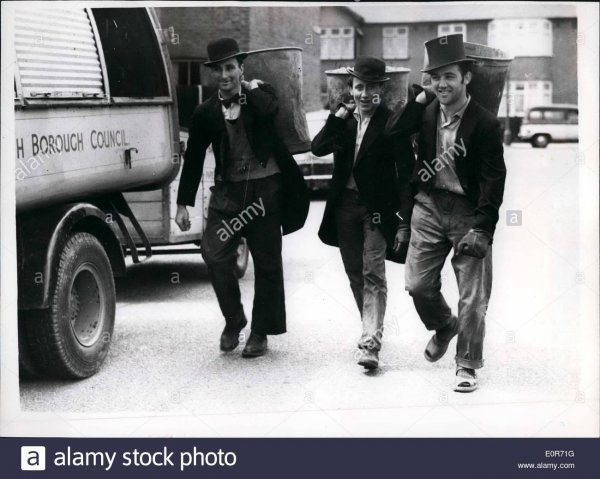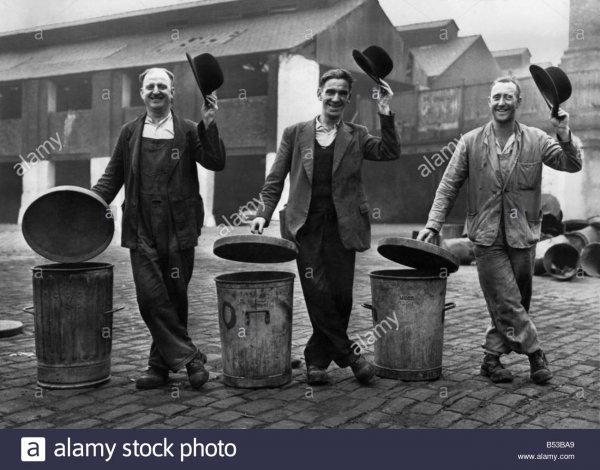Blackthorn
I'll Lock Up
- Messages
- 4,571
- Location
- Oroville
I’ve been musing about this subject for a long time, so now it’s time to give it a viewing here.
At the top we have, of course, the top hat, appropriately named. Top hats are for the elite whether of actual royalty or just the wealthy men, to wear at gala events or wherever they may want to wear them. I’m reminded of the various versions of Dickens’ Christmas Carol and how the rich financiers and investors are wearing their toppers. Or there’s the famous picture of JFK wearing his top hat and tuxedo…American royalty.
The next layer down are the homburgs, the lids worn by university professors or intellectuals of all kinds on a daily basis when they aren’t wearing their top hats to a formal event. Homburgs have a more European flavor. We don’t see them often in the U.S.
Next layer down the chain are the fedoras, worn in “the golden age” by average businessmen or even many tradesmen who could afford them. I have a picture of my dad wearing one in 1942 as he awaited his draft notice. He had been a farmworker all his life, but when he could finally put some money together and get a fedora, he felt like he had hit the big time. Now he could stop looking like a hillbilly (his words, not mine). He was very proud to be seen in it when he drove into town after a hard day in the cotton fields. After he got back from the War, he wore it in his new trade of carpentry. Gangsters, detectives, newspaper reporters, insurance salesmen—they all wore fedoras.
At the bottom of the list is the flat cap…newsboy, ivy, apple jack…whatever name works for the part of the globe where the wearer finds himself. They were and are worn by newspaper sellers, shoeshine men, taxi drivers, dock workers, gardeners, horse grooms. I take pride in wearing them as I think of myself as being of solid peasant stock. Cap wearers couldn’t afford any of the styles listed above. The caps were made of wool or cotton and thus were much more affordable.
I’m reminded of Schindler’s List where the Nazis are sorting out those who can be used by the Third Reich and those who can’t. One Nazi screener is interviewing a Jewish university professor (who is wearing a fedora), and the professor is saying, “What do you mean teaching history isn’t important to society?” Ben Kingsley’s character jerks the guy out of line and in the next scene the same character is back, wearing a flat cap and saying, “I’m a metal polisher.” I can’t think of a more profound example of what a difference in social class can be shown by hat styles.
The only thing that doesn’t fit these general rules, as I see them, are golfers who wear flat caps. It takes money to play golf, but frequently they wear the flat caps…it doesn’t compute, but there you have it.
Cowboy hats, straw hats for farmworkers, baseball caps…all are deserving of a post for another day.
Your mileage may vary. I expect it will.
At the top we have, of course, the top hat, appropriately named. Top hats are for the elite whether of actual royalty or just the wealthy men, to wear at gala events or wherever they may want to wear them. I’m reminded of the various versions of Dickens’ Christmas Carol and how the rich financiers and investors are wearing their toppers. Or there’s the famous picture of JFK wearing his top hat and tuxedo…American royalty.
The next layer down are the homburgs, the lids worn by university professors or intellectuals of all kinds on a daily basis when they aren’t wearing their top hats to a formal event. Homburgs have a more European flavor. We don’t see them often in the U.S.
Next layer down the chain are the fedoras, worn in “the golden age” by average businessmen or even many tradesmen who could afford them. I have a picture of my dad wearing one in 1942 as he awaited his draft notice. He had been a farmworker all his life, but when he could finally put some money together and get a fedora, he felt like he had hit the big time. Now he could stop looking like a hillbilly (his words, not mine). He was very proud to be seen in it when he drove into town after a hard day in the cotton fields. After he got back from the War, he wore it in his new trade of carpentry. Gangsters, detectives, newspaper reporters, insurance salesmen—they all wore fedoras.
At the bottom of the list is the flat cap…newsboy, ivy, apple jack…whatever name works for the part of the globe where the wearer finds himself. They were and are worn by newspaper sellers, shoeshine men, taxi drivers, dock workers, gardeners, horse grooms. I take pride in wearing them as I think of myself as being of solid peasant stock. Cap wearers couldn’t afford any of the styles listed above. The caps were made of wool or cotton and thus were much more affordable.
I’m reminded of Schindler’s List where the Nazis are sorting out those who can be used by the Third Reich and those who can’t. One Nazi screener is interviewing a Jewish university professor (who is wearing a fedora), and the professor is saying, “What do you mean teaching history isn’t important to society?” Ben Kingsley’s character jerks the guy out of line and in the next scene the same character is back, wearing a flat cap and saying, “I’m a metal polisher.” I can’t think of a more profound example of what a difference in social class can be shown by hat styles.
The only thing that doesn’t fit these general rules, as I see them, are golfers who wear flat caps. It takes money to play golf, but frequently they wear the flat caps…it doesn’t compute, but there you have it.
Cowboy hats, straw hats for farmworkers, baseball caps…all are deserving of a post for another day.
Your mileage may vary. I expect it will.




